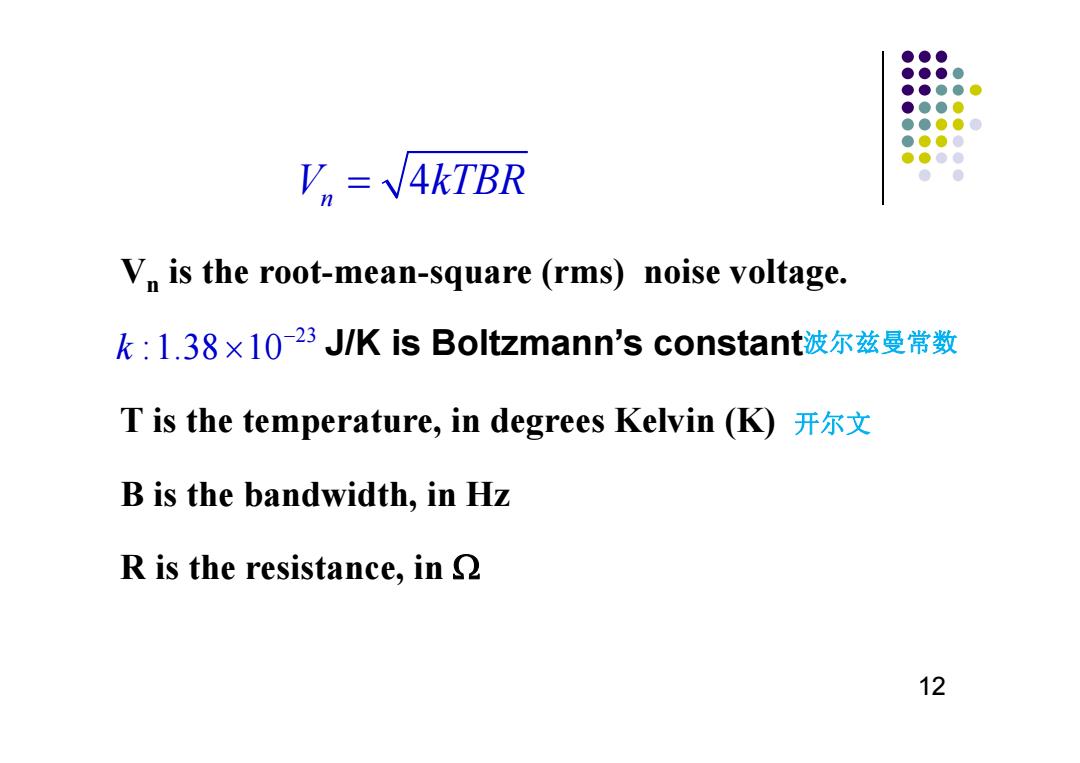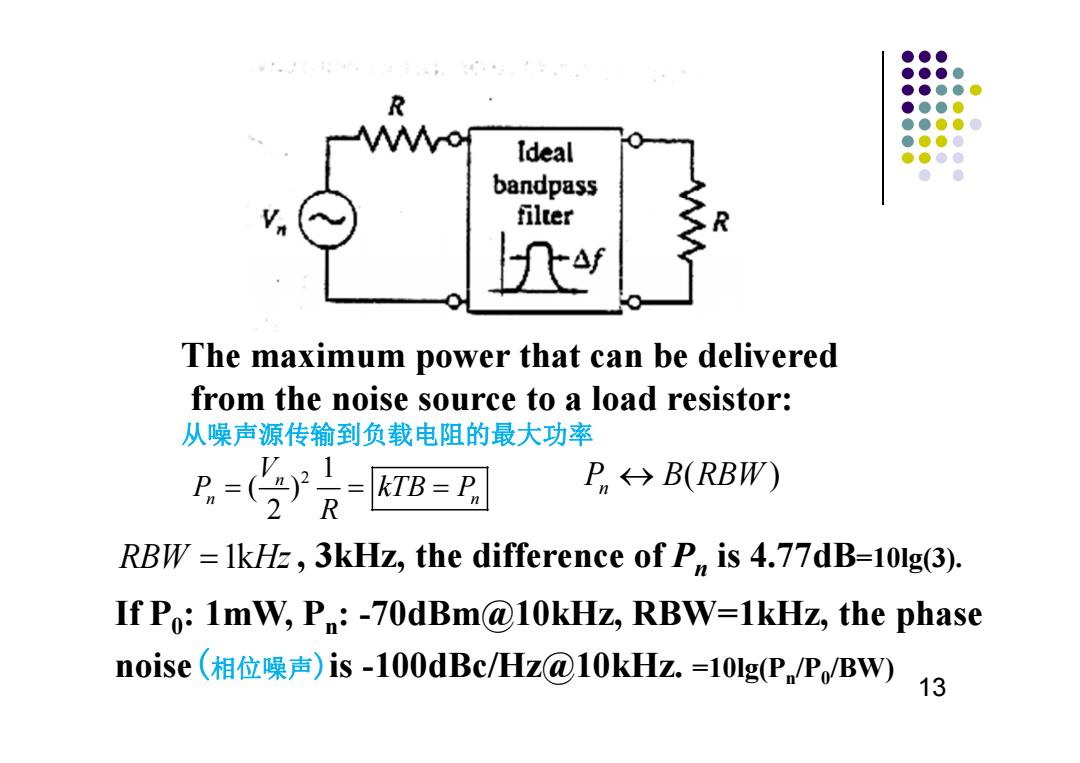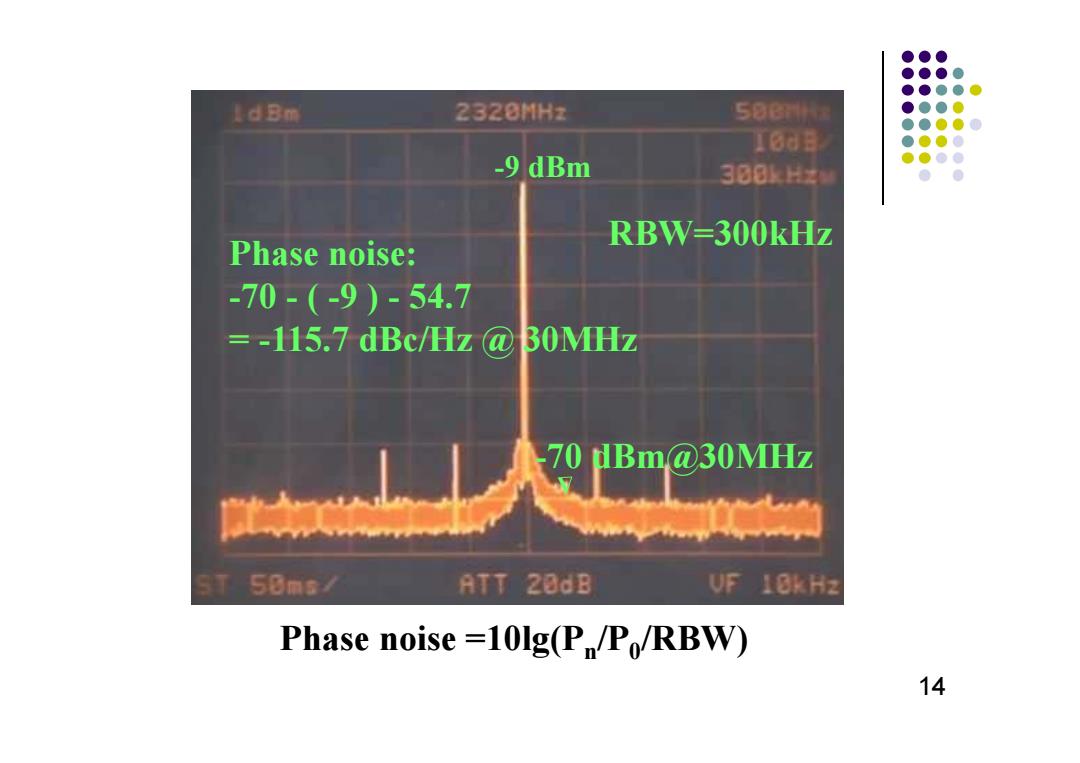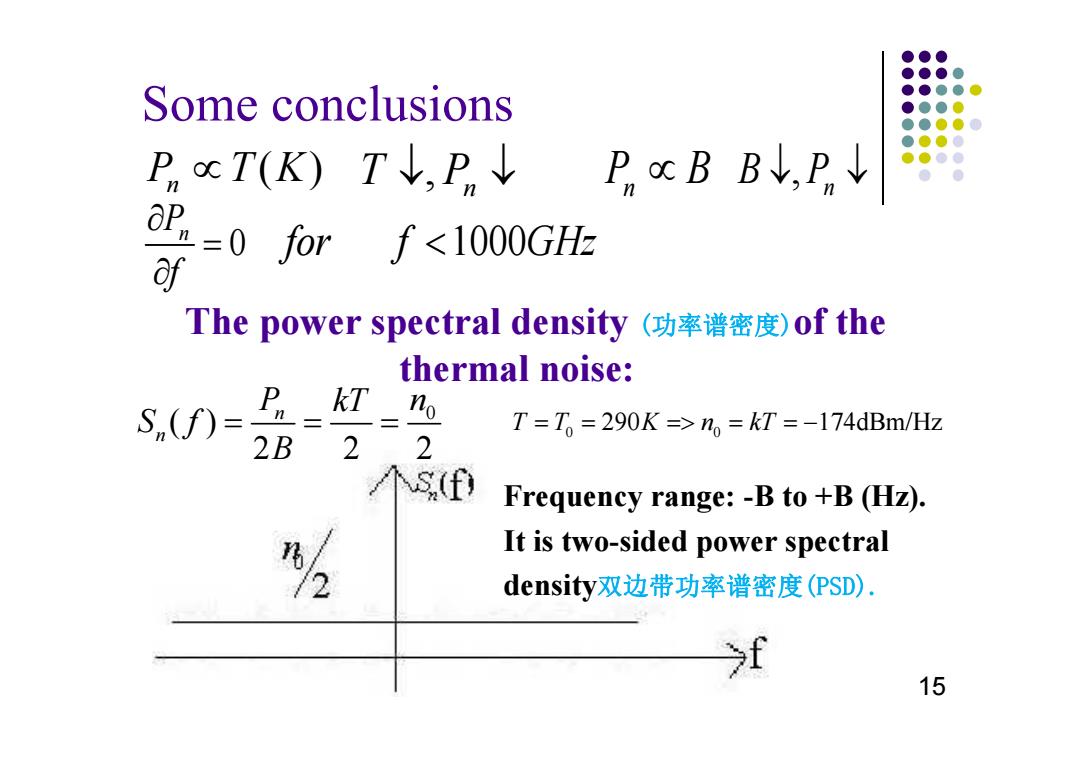
●●● ●●●● ●●●●● ●●●0 ●●●●● ●●●0 ●●●● V=4kTBR ● ● V is the root-mean-square(rms)noise voltage. k:1.38×1023J/K is Boltzmann's constant波尔兹曼常数 T is the temperature,in degrees Kelvin(K)开尔文 B is the bandwidth,in Hz R is the resistance,in 12
T is the temperature, in degrees Kelvin (K) 开尔文 B is the bandwidth, in Hz R is the resistance, in 23 k :1.38 10 J/K is Boltzmann’s constant 4 V kTBR n 12 V n is the root-mean-square (rms) noise voltage. 波尔兹曼常数

●●● ●●●● ●●●●● R ●●●0 ●●●●0 o Ideal ●●●● ●●● bandpass ● ● filter The maximum power that can be delivered from the noise source to a load resistor: 从噪声源传输到负载电阻的最大功率 R-宁分}员B=巴 P←→B(RBW) RBW 1kHz,3kHz,the difference of P,is 4.77dB=101g(3). If Po:1mW,P:-70dBm@10kHz,RBW=1kHz,the phase noise(相位噪声)is-100dBc/Hz@10kHz.=10lgP.PJBW) 13
( ) Pn B RBW RBW Hz 1k , 3kHz, the difference of Pn is 4.77dB=10lg(3). If P0: 1mW, Pn: -70dBm@10kHz, RBW=1kHz, the phase noise(相位噪声)is -100dBc/Hz@10kHz. =10lg(Pn/P0/BW) The maximum power that can be delivered from the noise source to a load resistor: 从噪声源传输到负载电阻的最大功率 13 2 1 ( ) 2n n n V P kTB P R

●●● ●●●● ●●●●● IdBm 2320MHz 598m ●●●0 ●●●●0 108日 ●●●● -9 dBm ●●●● 308kH士 ●● RBW=300kHz Phase noise: -70-(-9)=54.7 =-115.7 dBc/Hz @B0MHz 70 dBm.@30MHz 58ms/ ATT 20dB VF 10kHz Phase noise =10lg(P/Po/RBW) 14
14 -70 dBm@30MHz RBW=300kHz Phase noise: -70 - ( -9 ) - 54.7 = -115.7 dBc/Hz @ 30MHz -9 dBm Phase noise =10lg(P n/P 0/RBW)

●●●】 ●●●● ●●●● Some conclusions ●●●0 ●●●● ●●●● P,cT(K)TV,p P BB,Pn↓ ●●● ●● aP =0forf<1000GH2 of The power spectral density(功率谱密度)of the thermal noise: kT S,()= P= no T=To =290K =>no kT=-174dBm/Hz 2B 22 个sf Frequency range:-B to +B(Hz). It is two-sided power spectral 2 density.双边带功率谱密度(PSD). >f 15
Some conclusions ( ) Pn T K , T P n Pn B , B P n 0 Pn f for f GHz 1000 15 Frequency range: -B to +B (Hz). It is two-sided power spectral density双边带功率谱密度(PSD). 0 ( ) 2 22 n n P kT n S f B The power spectral density (功率谱密度)of the thermal noise: 0 0 T T K n kT 290 174dBm/Hz

●●● 3.3 Noise in Linear System ●●●● ●●● 线性系统中的噪声系数 ●●● ●●● 1.The output response of a linear time-invariant ●●●● system线性时不变系统的输出响应 S,(@)=H(@S.(@) x(t) h() y() R(T).S(w) H(o) R,(r).S,(@) S,(@)----input PSD,Sy(o)----output PSD, H()----transfer function. 2.Gaussian White Noise through an Ideal Low-pass Filter 高斯白噪声通过理想的低通滤波器 H) Input port:S,()= Output port:S,(f)=H(f)s (f No=Afio -4f △f y-6hy The output noise power is proportional to the filter handwidth. 输出的噪声功率与滤波器的带宽成正比 16
§3.3 Noise in Linear System 线性系统中的噪声系数 1. The output response of a linear time-invariant system线性时不变系统的输出响应 Sx(ω)----input PSD,Sy(ω) ----output PSD, H(ω) ----transfer function. The output noise power is proportional to the filter handwidth. 输出的噪声功率与滤波器的带宽成正比 N fn 0 0 2. Gaussian White Noise through an Ideal Low-pass Filter 高斯白噪声通过理想的低通滤波器 Input port: Output port: 16 2 ( ) ( ) S( ) y x S H 0 ( ) 2 ni n S f 2 0 () () () n ni S f Hf S f 1 ( ) 0 for f f H f for f f